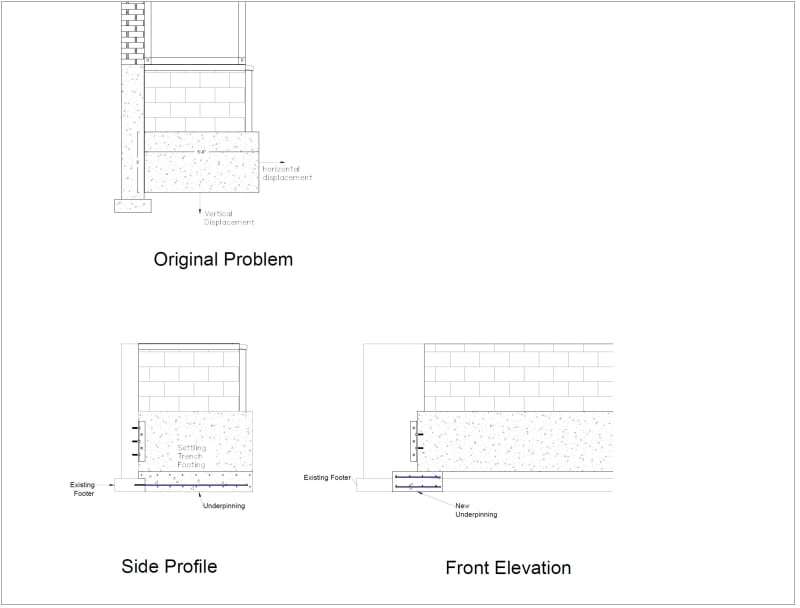peteotoole
Civil/Environmental
- Mar 23, 2021
- 4
I am working on my senior design and I have run into a problem in finding relevant information for a design of an underpinning. Attached are the photos of the underpinning design but I am having problems with relevant codes and specifications.
First the structure under consideration is small (5-8"' x 20' as bird views it) and it was determined the structure (which was an addition, one story atrium) was added on and built on backfilled soil and it was never connected to the existing building (existing building built in 1950 with no displacement, atrium built in 2002 with a lot of displacement). Through talking to the cities engineers as well as a mentor engineer I am designing an underpinning that abuts existing concrete (smooth) on one of its transverse faces as well as on top of the underpinning by an existing trench footer.
The questions I have are as follows:
Since I can't find underpinning code I treated the underpinning as a footing with a continuous foundation on top which transfers the load through the trench footing (treated as a wall) onto the footer underpinning and used that method to determine my rebar. I am assuming no moments or eccentric loading on this underpinning. Is that a fair way to get Area of rebar required using ACI foundation codes for shear and flexure?
Secondly where the new concrete meets existing concrete I was going to provide rebar dowels into the old structure to combine the two structure (the underpinning and old structure) and was looking at grouting the embedment but that only seems relevant to shear dowels and then I am questioning whether doweling into the old structure is even necessary. It doesn't even seem the epoxy grout shortens the development length so why is this necessary?
Lastly I have drawn in a leg angle and bolts as a way to use some code I can find to connect the two because I am unable to find much with the connection of the two structures. I can find ACI code on anchoring and can put numbers to that, but it doesn't seem ideal.
Any help with sources or useful documentation would be greatly appreciated. Yes I have considered piles, micropiles, et cetera but we have settled on underpinning so you might think piles are the best thing since slic3r but we aren't going back at this point.

First the structure under consideration is small (5-8"' x 20' as bird views it) and it was determined the structure (which was an addition, one story atrium) was added on and built on backfilled soil and it was never connected to the existing building (existing building built in 1950 with no displacement, atrium built in 2002 with a lot of displacement). Through talking to the cities engineers as well as a mentor engineer I am designing an underpinning that abuts existing concrete (smooth) on one of its transverse faces as well as on top of the underpinning by an existing trench footer.
The questions I have are as follows:
Since I can't find underpinning code I treated the underpinning as a footing with a continuous foundation on top which transfers the load through the trench footing (treated as a wall) onto the footer underpinning and used that method to determine my rebar. I am assuming no moments or eccentric loading on this underpinning. Is that a fair way to get Area of rebar required using ACI foundation codes for shear and flexure?
Secondly where the new concrete meets existing concrete I was going to provide rebar dowels into the old structure to combine the two structure (the underpinning and old structure) and was looking at grouting the embedment but that only seems relevant to shear dowels and then I am questioning whether doweling into the old structure is even necessary. It doesn't even seem the epoxy grout shortens the development length so why is this necessary?
Lastly I have drawn in a leg angle and bolts as a way to use some code I can find to connect the two because I am unable to find much with the connection of the two structures. I can find ACI code on anchoring and can put numbers to that, but it doesn't seem ideal.
Any help with sources or useful documentation would be greatly appreciated. Yes I have considered piles, micropiles, et cetera but we have settled on underpinning so you might think piles are the best thing since slic3r but we aren't going back at this point.

